Not a bad 10th birthday present for the House, which opened in
2008 and was designated Ireland’s
National Opera House
in 2014, and one which this year’s Festival confirmed is greatly deserved.
Opening night offered a double dose of verismo viciousness and violence: a
compelling alternative to Cav & Pag. Born in 1864, Leoni
studied alongside Puccini and Mascagni at the Milan Conservatoire under the
supervision of Amilcare Ponchielli and Cesare Dominicetti. When he
emigrated in London in 1892, aged 28, Londoners took the Milanese composer
of operas, sacred works and ballads to their hearts. “Signor Leoni,
although a foreigner, has … proved himself a better friend to the cause of
English music than most people seem inclined to admit,” wrote ‘G.H.C.’ in
the Observer on 7th November 1909, and his view seems
to have been shared by many, if contemporary newspaper reports and letter
pages are anything to go by.
Correspondents praised Leoni’s instigation of the foundation of the Queen’s
Hall Choral Society, of which he became conductor, and admired his
endeavours “to inspire his chorus with a genial, warm Southern enthusiasm
[…] the general effect produced is keen and musicianly in the best sense of
the word”. After a performance of Leoni’s oratorio Golgotha at the
Queen’s Hall in 1911 one enthusiast, James Bernard Fagan, expressed the
somewhat florid opinion that “Mr Leoni has done for sacred music what
Francis of Assisi did for Christianity, bidding us look for the spirit of
God not in cold, gloomy, formless abstractions on remote unscalable
heights, but down on the warm earth – in trees and in flowers and in
running waters, in the birds and in the beasts, and in the hearts of men”.
There’s not much evidence of “the spirit of God” in L’oracolo ( The Oracle) which premiered at Covent Garden on 28th
June 1905, conducted by AndrÈ Messager and with Antonio Scotti playing the
vicious and venal Cim-Fen. Set in an opium den in San Francisco’s
Chinatown, Camille Zanoni’s libretto – based on a Chinese-American story, The Cat and the Cherub, by Chester Bailey Fernald – is swift and
sensational. It crams villainy and viciousness, kidnapping and stabbing,
strangulation and insanity into its sixty minutes. Its personnel include
gamblers and fortune-tellers, drug addicts and reprobates, as well as
chattering choruses of children and vendors. The action takes us through
the seedy back-streets of 1900 Chinatown, down alley-ways which are choked
by the San Francisco fog and the festering stench of the running drains,
and teaming with caterwauling costermongers. The opium dens of ‘Hatchet
Row’ are ruled by Cim-Fen, a merciless cut-throat who wields his knife with
slickness and a smile.
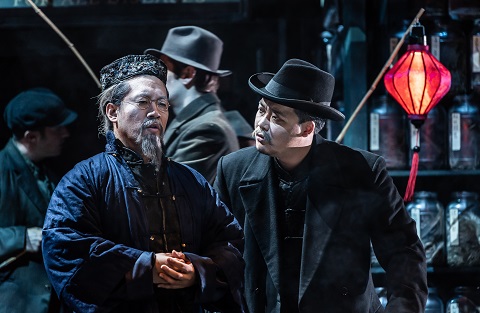 Leon Kim and Joo Won Kang. Photo Credit: Clive Barda.
Leon Kim and Joo Won Kang. Photo Credit: Clive Barda.
The eponymous Oracle predicts that two people will die, and murder follows
murder with chilling speed and inevitability. When San-Lui discovers that
Cim-Fen has kidnapped the child of the wealthy merchant Hu-Tsin – in a ploy
to win the hand of Hu-Tsin’s niece, Ah-Joe, by heroically ‘rescuing’ the
infant – Cim-Fen despatches his love rival with an efficient single
hatchet-blow to the back of the head. Uin-San-Lui’s father, Uin-ScÓ, may be
of philosophical bent, but that doesn’t stop him displaying his own
thuggish resourcefulness and expertise in seeking vengeance. When the blade
that he has plunged into Cim-Fen’s back fails in its fatal intent, Uin-ScÓ
calmly winds his son’s killer’s plait around his neck and with delicate
deliberation proceeds to strangle him. So peacefully occupied in quiet
conversation do the pair appear, seated side-by-side on a bench, that a
passing policemen notices nothing amiss.
Director Rodula Gaitanou and designer Cordelia Chisholm leave us in no
doubt of the squalor and sadism of life in the ghetto. Dimly lit by Paul
Hackenmueller, Chisholm’s set is dominated by a towering, three-story brick
edifice which revolves to reveal the business premises of Dr Uin-ScÓ, a
Chinese herbalist, the imposing entrance to the domestic quarters of
Hu-Tsin, and the red-lit steps which descend into the bowels of Cim-Fen’s
opium den. We are swirled along with the chattering Chinese inhabitants
through the network of grimy alleyways. A corner street-light illuminates
the coarseness and brutality of the gamblers, drug-takers and drinkers
departing Cim-Fen’s den: knives flash in the lamp-light gloom, fists lash
out, grievances are born and nurtured. Even the festive spectacle of a
Chinese New Year Dragon Procession doesn’t alleviate the shabby sleaziness:
the festooning red balloons can’t hide the shabbiness of the parading
wagons, and the arching Dragon dips and dives menacingly, glaring with a
mean, sharp-toothed stare.
Much of the success of L’oracolo was due to Scotti’s championing
of the opera at the Met, where he persuaded General Manager Giulio
Gatti-Casazza to present the work in 1915. It became a star vehicle for
Scotti – often paired with Cavalleria Rusticana, Pagliacci, L’Amico Fritz and even La boh Ëme – until 1933, when the 55th performance of the
opera served as the Italian baritone’s farewell to the house. Here, Joo Won
Kang was entrusted with embodying the repugnant Cim-Fen, and his baritone
was darkly aggressive at the bottom, richly coloured in the middle and firm
of weight throughout. As Uin-San-Lui, Sergio Escobar provided complementary
lightness and beauty, his tenor ringing brightly at the top, though there
was little chemistry between Escobar and Elisabetta Farris’s Ah-Joe. But,
if their voices didn’t blend with sufficiently powerful rhapsodic intimacy
in the duet which is ended by Cim-Fen’s plunging knife, then the gentle
beauty of Farris’s soprano did win our pity for the suffering girl, though
Gaitanou did little to suggest that Ah-Joe’s grief was followed by mental
derangement.
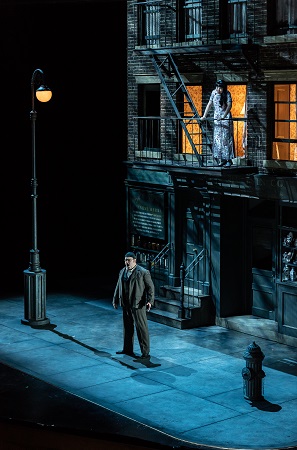 Sergio Escobar and Elisabetta Farris. Photo Credit: Clive Barda.
Sergio Escobar and Elisabetta Farris. Photo Credit: Clive Barda.
Leon Kim was superb as Uin-ScÓ, his grave and authoritative manner never
concealing the sincerity of his love or integrity of his belief: the
bereaved father’s appeal to the ‘Supreme Divinity of the Western Sky’ to
reveal his son’s assassin was both chilling in its implications and
compelling in its genuinely human motivation. The role of Hu-Tsin was
commandingly sung by Benjamin Cho, while Louise Innes acted and sang
convincingly as Hua-QuÓ, nurse to the kidnapped Hu-CÓ. The latter was
portrayed with infectious spiritedness by Cillian McCamley, who yawned
cheekily during the adults’ rituals and sprinted around mischievously
before he was imprisoned by Cim-Fen, first a garbage bin, then down the
coal chute.
Conductor Francesco Cilluffo – who led
Mascagni’s Isabeau
impressively at Opera Holland Park this summer – had the measure of the
score’s melodrama and pace, finding both stirring passion and moments of
lightness, and the Orchestra of Wexford Festival Opera painted the diverse
local colours with vividness and energy. There was especially fine playing
from the lower strings, particularly during Uin-ScÓ’s retributive prayer
and vow.
Despite the unalleviated ruthlessness and savagery which Leoni and Zanoni
dish up, Gaitanou obviously felt there was room for more. Leon Kim’s
Chinese herbalist did not consider throttling-by-pigtail to be sufficient
punishment for his son’s murderer: instead, he exercised a ritual
disembowelment of the barely-breathing Cim-Fen, slicing through clothes,
peeling back skin and plunging his hand into the cut-throat criminal’s
chest – should we have been in doubt, by the close the latter really was
‘heartless’. And, though the libretto ends with Uin-ScÓ’s vengeful actions
undiscovered, here the clinical killer immediately confessed his crime to
the passing policeman, crossing his wrists to indicate that the cuff-links
should be clicked into place. The result was not the resumption of ‘normal’
life with which the original concludes, but the unbalancing of the scales
of justice.
After the interval, Chisholm’s set was deftly transformed – out with the
herbalist and in with Valentino’s cobbler’s shop, the Bella Napoli
cafÈ replacing the opium den, and laden washing-lines adding to the
authenticity of the milieu in the second Act – in order to transfer us from
San Francisco’s Chinatown at the turn of the century to New York’s Little
Italy in the 1950s. There are no knifings or strangulations in Umberto
Giordano’s Mala vita but, like L’oracolo, for a
relatively small-scale drama the large-scale musical climaxes pull no
emotional punches and hit the theatrical bull’s-eye. Librettist Nicola
Daspuro’s lurid tale of Neapolitan low-life – based on a play by Salvatore
Di Giacomo and Goffredo Cognetti, which was itself derived from Giacomo’s
1888 short story Il voto (The vow) – was a success at its premiere
in Rome’s Teatro Argentina in February 1892, and also surprisingly
well-received when, translated into German, it was subsequently presented
in Germany and Austria. But, Mala vita didn’t go down so well with
the Neapolitans, who were less appreciative of Giordano’s ‘veristic’ – in
their eyes, insulting – depiction of the ‘wretched lives’ endured in
Naples’ ugly alleyways and slum dwellings.
The opera takes us into what Matilde Serao, the author of Il ventre di Napoli (1884), described as ‘the bowels of Naples’.
Vito, who works in a dye-house, believes that the tuberculosis that
afflicts him, rather than being an inevitable consequent of the chemicals
and fumes he ingests each day, is a punishment from God for his
misdemeanours – including his affair with Amalia, of which only her
coachman husband Annetiello seems unaware. In hope of a cure and divine
forgiveness, Vito vows to give up Amalia and marry a prostitute, thereby
saving the fallen woman from a life of degradation and his own soul from
damnation. News of his vow travels fast through the slum alleyways and when
Cristina drops a rose from her brothel window onto the passing Vito’s
shoulders, she is chosen as his path to redemption – to the brothel-regular
Annetiello’s amusement and Amalia’s anger. The latter confronts Cristina,
and Vito, unable to resist Amalia’s wiles and charms, ditches Cristina
along with his plans for physical and moral improvement, leaving Cristina
to lament that Jesus obviously didn’t want her to be redeemed after all.
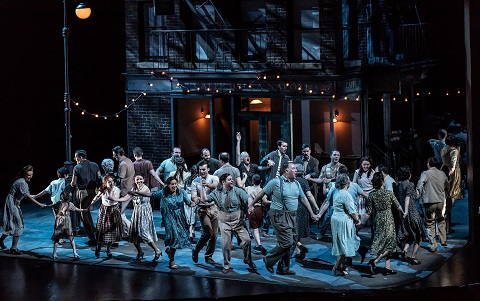 Chorus of Mala vita. Photo Credit: Clive Barda.
Chorus of Mala vita. Photo Credit: Clive Barda.
The expansive anguished and impassioned outbursts of the three protagonists
stand out against the musical ‘backdrop’ provided by Giordano of everyday
neighbourhood goings-on, and the Wexford Festival Chorus sang, and danced,
with real spirit and vivacity. Gaitanou blocked the ensemble scenes more
successfully than in L’oracolo, where occasionally the narrow
street-strip at the front of the stage seemed crowded and the Dragon
procession felt less than fluid. In contrast, the traditional Piedigrotta procession and festivities were vividly animated: the
tarantella sprang ebulliently as the Neapolitan folk songs rang out
colourfully, the snaking lines of revellers intertwined dexterously, and
the children practised their dance-steps at the side of the stage.
Similarly, the Chorus captured the intensity of the community’s belief in
popular local superstitions during the opening vow scene.
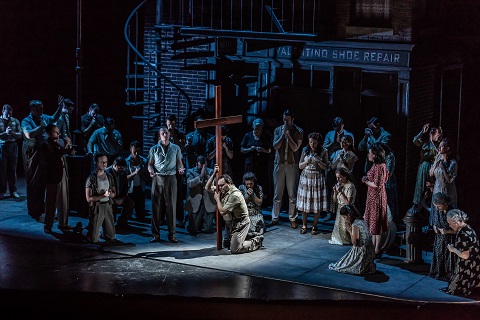 Sergio Escobar and Chorus. Photo Credit: Clive Barda.
Sergio Escobar and Chorus. Photo Credit: Clive Barda.
Escobar was able to tap all the warm lyricism of his tenor and did his best
to make Vito’s lurches from fervent prayer to ardent romance convincing, as
he switched from devout consumptive to devious charmer in the blink of an
eye. The characterisation is largely conveyed through the three main duets
which bring Vito and Cristina together in Act 1, Amalia and Cristina into
confrontation in Act 2 and subsequently reunite Amalia and Vito, and
Escobar was well-partnered by both Dorothea Spilger’s Amalia and Francesca
Tiburzi’s Cristina. Spilger was a powerful presence especially in Act 2,
which Amalia dominates, communicating all of Amalia’s selfishness,
recklessness and wilfulness. Her mezzo-soprano is powerful and focused, and
in the lunchtime recital which she gave the following day, in St Iberius’s
Church, she revealed its full range of colour, vibrancy and intensity, the
dense layers of the bottom being complemented by strikingly intense and
pure top notes. Spilger moved effortlessly between high and low, too, and
her presentation of songs by Brahms, Schumann and Richard Strauss, and an
aria from Leh·r’s Zigeunerliebe, confirmed her flawless technique
and assurance, and dramatic range.
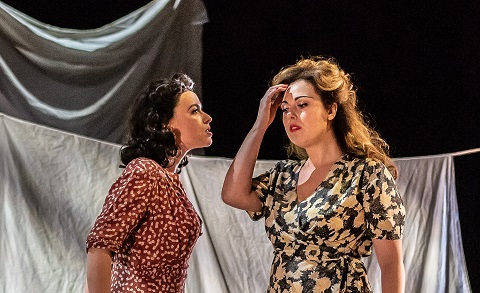 Dorothea Spilger and Francesca Tiburzi. Photo Credit: Clive Barda.
Dorothea Spilger and Francesca Tiburzi. Photo Credit: Clive Barda.
In Mala vita, however, it was Tiburzi’s Cristina who
almost stole the show with her Act 3 prayer, in which the sensuous richness
of her mezzo suggested, ironically, that her real passion and fervour was
reserved for the spiritual rather than the earthly. Tiburzi had terrific
rapport with Escobar’s Vito, and in their Act 1 duet the lucidity and
elegance of line evoked the tenderness of a Puccinian melody. Annetiello is
a rather limited role (when Giordano revised the opera and represented it
as Il voto (The vow) in 1897, he omitted the character)
though Leon Kim made the most of it, relaxing his baritone to suggest a
good-time-lad preoccupied with the pleasures in life. He joyfully
anticipated the hedonistic excesses of the festival to come, as he prepared
his horses’ harnesses and plumes, and joined his mates in a rousing
brindisi in Act 3. Benjamin Cho and Anna Jeffers provide good support in
the roles of Marco and Nunzia respectively.
Cilluffo again conducted with conviction, driving the orchestra to emotive
act closures and summoning a rich palette during the Intermezzo in Act 2
which provides some musical pathetic fallacy during the storm, while also
creating moments of intimacy through some excellent quiet string passages.
Gaitanou once again exercised directorial license with the ending. In the
libretto, as Cristina ends her prayer, the folk song which Annetiello has
sung during the festivities is heard again, reminisced by the off-stage
chorus, suggesting that while Cristina suffers alone the indifferent
community continue their Piedigrotta revels. The sound of the song
rouses Cristina who cries contemptuously, “Infami! Vili! Ah!”, before
rushing back towards the door of the brothel. Gaitanou clearly can’t
envisage Cristina resuming her former employment, so she has the prostitute
put a gun to her head and pull the trigger. Giordano, like Leoni, takes the
action back to where it started: no moral judgements are made, this is
simply how these people live their lives. I would have preferred this
‘slice of life’ plain, without any aesthetic air-brushing.
Indeed, ‘endings’ proved rather problematic at Wexford this year! So
composer William Bolcom and librettist Mark Campbell explained during their
‘Meet the Creators’ talk, the morning following the European premiere of Dinner at Eight, a co-production with Minnesota Opera where the
opera was first seen in March 2017. Campbell’s libretto offers a very
different ‘slice of life’. Based on George S. Kaufman and Edna Ferber’s
1932 play, Dinner at Eight is a black comedy which pillories and
pities the desperate efforts of a bunch of nervy New York socialites to
keep up appearances as the miseries of the Depression, and their own
foibles and moral weaknesses, threaten to bring their paper-thin social
edifices tumbling down.
During the week preceding Millicent Jordan’s eponymous dinner, the hostess
frets about the fate of the gastronomic centrepiece as the lobster-in-aspic
nose-dives to the kitchen floor; wails about the lone Hungarian viola
player who replaces the planned string quartet; and hysterically laments
the non-show of her prime exhibits, Lord and Lady Ferncliffe, who forgo her
hospitality for the sunshine of Florida. Meanwhile, her guests struggle
with rather more significant worries and reveal their instabilities,
insecurities and immoralities. Oliver Jordan’s fragile grip on his shipping
line company is being loosened by former actress Carlotta Vance’s need to
sell her stock to avoid insolvency, and by the treacherous double-dealing
of Dan Packard, a capitalist with political aspirations that his wife
Kitty, who is having an affair with her doctor, Joseph Talbot, threatens to
undermine. The Jordans’ daughter Paula wants to ditch her boring fiancÈ for
the charms of former matinÈe idol Larry Renault, an aging has-been whose
alcoholism has ravaged the good looks that were his only asset, and who has
just been dropped from the cast of his latest Broadway play.
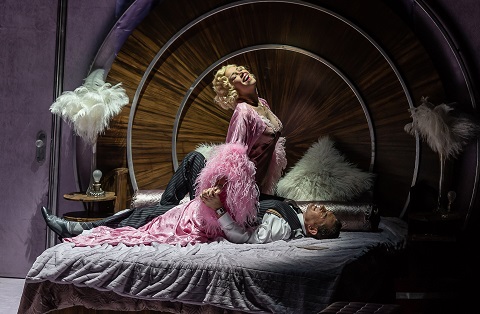 Susannah Billar and Brett Polegato. Photo Credit: Clive Barda.
Susannah Billar and Brett Polegato. Photo Credit: Clive Barda.
Set designer Alexander Dodge has supplied beautiful milieus for Tomer
Zvulun’s production, and the sleek art deco elegance is charmingly
complemented by Victoria Tzykun’s costumes and boldly lit by Robert
Wierzel. The set is framed by a monochrome topographic jigsaw of
Manhattan’s monuments – think Escher meets Google Satellite – and screened
snippets of the Depression era nod towards the drama’s cinematic past
(George Cukor’s 1933 film adaptation included John Barrymore, Jean Harlow,
Marie Dressler, Lionel Barrymore and Lee Tracey, among others, in its
ensemble cast). Time and place are well-defined: as Bolcom explained, the
play was designed for a ‘local’ audience whereas the film had appealed to a
broader set of ‘national’ viewers. The clean, cream splendour of the
Jordans’ sparkling chandeliers and tortoise-shell inlays is juxtaposed with
the tasteless trappings of the Packards’ gaudy, glitzy bedroom where Kitty
reclines on the king-size bed, scoffing chocolates from a heart-shaped box
and admiring her jewellery as she awaits the next dose of the doctor’s
‘medicine’. We see inside the clinical offices of Oliver Jordan and Dr
Joseph Talbot, the walls sporting photographs of cruise liners and
cross-sections of the human brain respectively, and witness Paula’s efforts
to convince Larry to elope in the charmless hotel room from which the
penniless thespian will shortly be evicted when the management’s patience
runs out.
Bolcom’s score is a skilful medley of varied pastiches, played by a
Broadway-tinted band that can swell with symphonic sumptuousness
in-between-scenes, and withdraw to sensitively support the aria-numbers
allotted to each of the struggling protagonists. There are some fine
woodwind colourings, toe-tapping rhythms, and lush climaxes, but while
slick, the score isn’t very memorable.
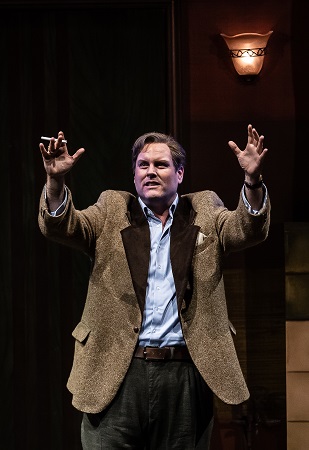 Richard Cox. Photo Credit: Clive Barda.
Richard Cox. Photo Credit: Clive Barda.
Several of the cast were reprising their roles from the original Minnesota
Opera production. Stephen Powell’s warm baritone made Oliver Jordan’s
vacillations between honest self-appraisal and the need to sustain
Millicent’s delusions and desires real and engaging, and Oliver’s nostalgic
duet with Brenda Harris’s larger-than-life but down-on-her-luck Carlotta
Vance was one of the musical highlights. Craig Irvin boldly captured Dan
Packard’s self-important, arrogant swagger. Susannah Biller’s gold-digging
doll, Kitty, was a perfect picture of frothy, pink-swathed self-indulgence;
it was hard to suppress a smile when Kitty’s maid, Tina, brightly sung by
Laura Margaret Smith, resorted to subtle threats of blackmail to wheedle a
diamante bracelet from her mistress. Sharon Carty impressed as Lucy Talbot,
skewering her philandering husband’s weaknesses in a strong, purposeful
aria of unflinching honesty, while Richard Cox conveyed all of Larry’s
despair, frustration and anger in a powerful, bitter aria of failure and
regret. Gemma Summerfield made much of Paula’s Act 1 lament about Larry’s
wavering and her romantic woes. Presiding overall all with assurance, gloss
and gleam was American soprano Mary Dunleavy’s Millicent – buoyant,
resourceful, and, despite her histrionic excesses, resilient to the last.
Bolcom’s Sondheim-style idiom is easy on the ear, but the score does not
itself have a ‘dramatic’ function. The following morning, Bolcom and
Campbell described Dinner at Eight as musical theatre sung by
opera singers: I’d go further and say that the music functions like a film
score, colouring and joining the scenes but not itself explicating the
characters’ motivations, actions and conflicts. Wexford’s Artistic Director
David Agler, who conducted the opera in Minnesota and led a slick and neat
performance here, has brought several American operas to Wexford during his
very successful tenure. I very much admired Carlisle Floyd’s Susannah, which formed part of Agler’s first festival programme in
2005, as well as John Corigliano’s
The Ghosts of Versailles
(presented in 2009), and Samuel Barber’s
Vanessa
(in 2016); but, I was less enamoured by Peter Ash’s
The Golden Ticket
(in 2010) or by Kevin Puts’
Silent Night
(in 2014). On this occasion, whatever my own misgivings, it’s fair to say
that during the first performance of Dinner at Eight the Wexford
clientele seemed absorbed and engaged.
And, so, what of the ‘ending’ that I mentioned above? A rhymed chorus gets
the show underway, as the servants line up to inform us, with insouciant
indifference to the impending tragedies, that “The party goes on, like it
or not”. And, so it does: despite all the heartache and imminent doom, the
gong sounds at eight o’clock and the guests take their places at the dinner
table. Oliver’s luxury liners are about to sink as fast as his company’s
share price, and he himself will succumb in three months to terminal heart
disease, according to Dr Talbot’s grim diagnosis. Larry has committed
suicide in his hotel room, by leaving the gas taps on, artfully arranging
himself in a chair in one last theatrical pose. Marriages, careers and
finances are floundering.
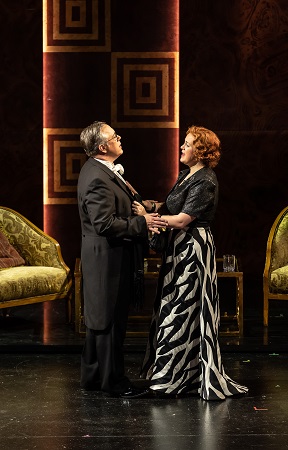 Stephen Powell and Gemma Summerfield. Photo Credit: Clive Barda.
Stephen Powell and Gemma Summerfield. Photo Credit: Clive Barda.
But, the Jordans vow that together they can survive both the evening’s
trials and any downturns or upsets that the future brings. And, that’s
that: curtain. It’s so inconclusive that the Wexford audience weren’t sure
if the opera had actually finished. Act 1 builds towards Millicent’s
spectacular hissy fit, and perhaps things should end there, as Act 2 has
little further to add. Or, perhaps the opera needs an Act 3, so that we can
find out what happens as the guests tuck into the spring lamb that the
caterers have delivered to replace the ill-fated crustacean? Whatever, the
current ending – which, we were told, the creators reworked when their
original idea proved unsatisfactory – leaves us teetering on a cliff-edge
then simply steps over the abyss and cheerily sweeps the brittleness aside.
Are we to presume that the dinner party goes smoothly and with a swing, to
the tuneful backdrop of a Hungarian czardas?
If there were unanswered questions at the close of Dinner at Eight
, then the plot of Saverio Mercadante’s Il bravo (1839)
proved unfathomable from the start, with the answers to some of the
libretto’s mysteries supplied only in the closing scene. Fortunately,
before these long-awaited revelations we had enjoyed three hours of
terrific singing and playing; I felt veritably swept along on the crest of
a grandiose musical wave of Verdian colour and energy.
Born in 1795, Mercadante was a significant figure in the world of
nineteenth-century Italian opera. During a career which overlapped with
Rossini, Bellini, Donizetti, and Verdi he composed sixty operas, and was
for thirty years (1840-1870) the director of the Conservatoire in Naples.
Wexford has previously shown faith in Mercadante, staging five of his
operas: Elisa e Claudio (1988), Elena da Feltre (1997), Il giuramento (2002), La vestale (2004) and
Virginia
(2010).
Il bravo
certainly confirmed the merits of Wexford’s conviction, though to say that
the plot is confused, and confusing, is something of an understatement.
Part of the problem is that too many pens have spoiled the plotting:
Antonio Bindocci, Gaetano Rossi, Marco Marcelliano Marcello, and Felice
Romani all worked on the libretto, which is based on the novel by James
Fenimore Cooper by way of Auguste Anicet-Bourgeois’s playLa Venitienne. Set in sixteenth-century Venice, the action begins in media res and without knowledge of prior events and the
historical background it’s virtually impossible to discern or make sense of
the characters’ motivations and relationships.
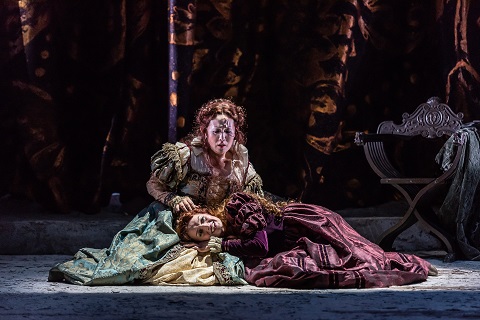 Yasko Sato and Ekaterina Bakanova. Photo Credit: Clive Barda.
Yasko Sato and Ekaterina Bakanova. Photo Credit: Clive Barda.
The characters assume multiple disguises and several names: Pisani, who
loves Violetta, sports the Bravo’s mask and dagger for much of the opera;
the Bravo himself dresses as a Dalmatian nobleman. The protagonists don’t
even recognise each other: it’s only at the end that the Bravo (real name,
Carlo Ansaldi), and Teodora (formerly known as Violetta) realise that they
are in fact husband and wife – Carlo, who had stabbed Violetta when he
suspected her of infidelity, had not killed her after all, and the younger
Violetta, whom he had ‘adopted’ in order to protect her from the dastardly
Foscari’s plans to abduct her, genuinely is his daughter.
The drama is driven by the Bravo’s obligation to act as the Council of
Ten’s assassin, in order that his father (jailed along with the Bravo for
suspected treason) might be spared the death penalty: but, in the closing
moments we learn that he has died in jail, so the pact, and its dreadful
consequences proves to have been pointless.
The blue mists that swirled across the Wexford stage at the start of Renaud
Doucet’s production certainly seemed – along with set designer AndrÈ
Barbe’s sharply angled perspectives of a Venice whose piazzas and waterways
are glimpsed through the narrow openings of up-turned palaces – an apt
metaphor for the plot’s obscurities. But, Doucet and Barbe muddy the canal
waters still further by introducing a troupe of twenty-first-century
tourists, trailing suitcases and taking selfies, who wander in anoraks and
sneakers amid the patrician Venetians attired in gloriously elaborate
sixteenth-century costume. Peering at maps and mobiles, they are apparently
just as ‘lost’ as we are – and, I decided, best ignored.
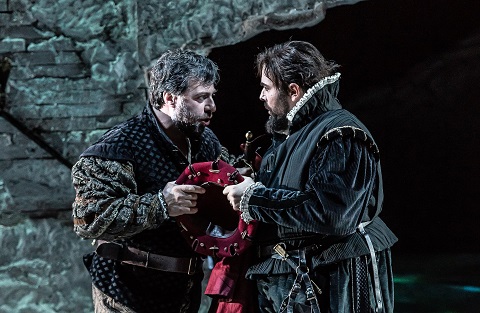 Rubens Pelizzari and Alessandro Luciano Photo Credit: Clive Barda.
Rubens Pelizzari and Alessandro Luciano Photo Credit: Clive Barda.
Indeed, it was easy to push the interlopers to the margins with such
terrific singing to distract one’s attention. In the title role, Rubens
Pelizzari gave a noble performance, attacking the lines cleanly with his
robust tenor. This was a convincing dramatic performance: when, in Act 1,
the Bravo returned to his home, divested himself of his mask and sang of
his sadness, the murdering henchman seemed less like Sparafucile and more
reminiscent of the tortured Rigoletto. In the second tenor role, Alessandro
Luciano was less strong as Pisani but he climbed easily enough to the top
and his phrasing was elegant.
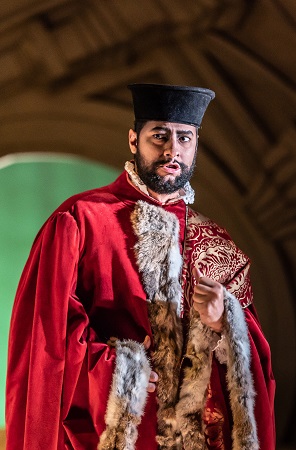 Gustavo Castillo. Photo Credit: Clive Barda.
Gustavo Castillo. Photo Credit: Clive Barda.
Baritone Gustavo Castillo was a fittingly menacing Foscari and agilely
negotiated his cabaletta in Act 1. Yasko Sato seemed a little
tentative at first, but her Teodora grew in stature and the Act 3 duet for
mother and daughter was the expressive peak of the performance. Ekaterina
Bakanova’s richly coloured soprano was just right for Violetta’s intensity
and integrity. Conductor Jonathan Brandani whipped up musical storms and
strife in the pit, drawing great energy from Mercadante’s striking
harmonies and rich instrumental colours, but he also respected Mercadante’s
more innovative and translucent orchestrations. All in all, the dramatic
muddle was more than outweighed by the splendid musical drama.
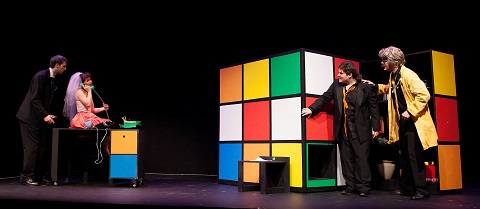 Cast of Don Pasquale. Photo Credit: Paula Malone Carty.
Cast of Don Pasquale. Photo Credit: Paula Malone Carty.
Alongside the three main productions, Wexford offered its customary three
‘Short Works’, performed at Clayton Whites Hotel, the first of which was an
abbreviated production of Donizetti’s Don Pasquale staged by
Kathleen Stakenas with music director Daniela Pellegrino. If Il bravo had shown just what a complex brain-teaser an opera
libretto can be, then Stakenas and designer Angela Giulia Toso chose,
literally, to house the Don in a Rubik Cube – an apt metaphor for the
puzzles and problems posed for the aging Don by his duplicitous doctor,
Malatesta, his nephew Ernesto, and the latter’s amour, Norina. One column
of the Cube was withdrawn to reveal the Library where, after his ‘marriage’
to ‘Sofronia’, Pasquale would find his ‘wife’s’ pink pompons, pelicans and
ponies perching next to his decanters and leather-bound tomes, as she
squandered his fortune on fluffy frivolities. Pasquale never did manage to
twist the clues into the right place and solve the riddle, but Stakenas
told the tale clearly, though the necessary excisions weakened our
appreciation of the schemers’ motivations – though, in any case, I always
find their machinations rather too cruel given Pasquale’s ‘crimes’.
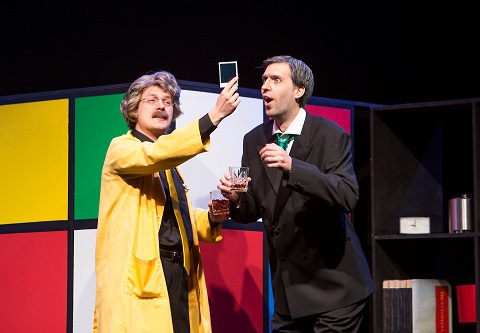 Simon Mechli?ski and Toni Neûi?. Photo Credit: Paula Malone Carty.
Simon Mechli?ski and Toni Neûi?. Photo Credit: Paula Malone Carty.
Toni Neûi?’s Don Pasquale was morose and muddled, rather than pompous and
furious, and in his oversize suit and shirt looked a portrait of
misguidedness and misery. Although, despite a liberal sprinkling of
hair-whitener, Neûi? didn’t look old enough to be Ernesto’s uncle, the
Croatian singer’s bass had a warm gravity and a persuasive maturity, and
his performance was consistent and engaging. As Norina, Barbara Cole Walton
displayed sheen and clarity at the top, and excellent intonation, but her
soprano was not equally weighted throughout her range, becoming a little
thin in the lower regions. She acted superbly though and, importantly, she
resisted over-acting as she commandeered the telephone, doubled the
butler’s salary, order to employ a hairdresser and jeweller to serve her
needs, and announced to the dismayed and deluded Pasquale that, as he
himself was too fat, old and decrepit, Ernesto would be her ‘cavalier’.
Antonio Mandrillo was a sweet-toned Ernesto, but his tenor lacks real heft
and he struggled a little with the dryness of the acoustic at Whites. Best
of the cast was Polish baritone Simon Mechli?ski: a wily and witty
Malatesta, he revealed a secure technique, a relaxed, agile baritone, and a
comfortable stage presence, manipulating his patient with glee and ease.
Neûi? and Mechli?ski proved equally adept in their patter duet, while
Mandrillo and Cole Walton blended well during their nocturnal rendezvous in
the Don’s garden.
The following lunchtime, Bernstein ‡ la carte proved less
satisfying. Director Roberto Recchia is a regular at Wexford and his Short
Work productions have offered much mirth and musical merit – including an
ingenious
L’elisir d’amore
in 2013,
La Cenerentola
the following year,
Donizetti’s II Campanello
in 2016, and
Rigoletto
last year.
This celebration of Bernstein’s ‘100th birthday’ fell a little
flat though: not that the performances of the seven-strong ensemble were
less than spirited and technically assured, rather that the situation – a
party held for ‘Lenny’ in which each singer unwrapped their ‘present’, one
of Bernstein’s scores, thereby prompting an aria or ensemble from the said
work – felt somewhat contrived. Despite the complementary primary colours
of the chaps’ sassy suits and lasses’ satin frocks, the milieu – white
Ikea-cubes, champagne bottles and some bright balloons – was rather
charmless, and the opening number, a medley which overlaid West Side Story’s duet, ‘Tonight’, sung powerfully by Gemma
Summerfield and James Lui, and the Quintet and Chorus of the same name,
didn’t sit very comfortably. The proceedings took a little while to get
into their stride too, though Summerfield did sterling work establishing
the context and holding things together. A screen at the rear showed images
of Manhattan, film and score playbills, and helpfully provided a guide
through the works performed – useful given that the roster included both
the familiar and the rare.
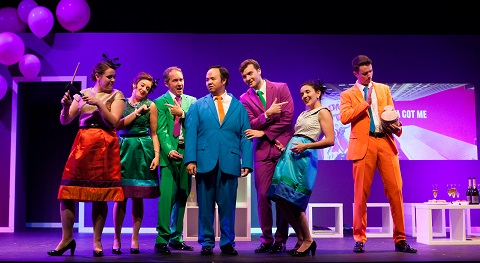 Cast of Bernstein ‡ la carte. Photo Credit: Paula Malone Carty.
Cast of Bernstein ‡ la carte. Photo Credit: Paula Malone Carty.
We were treated to numbers from Wonderful Town (including ‘What a
waste’ and ‘) and On the Town. ‘I can cook too’ from the latter
segued into La bonne cuisine, prompting a display of culinary
‘prowess’ from a team of chefs, who threw just about everything – including
a length of old rope, a rubber chicken and a decapitated fluffy bunny –
into the mix. Thankfully we were spared faux American accents, but some of
the numbers felt in need of a bit more schmaltz and jauntiness: ‘I am
easily assimilated’, from Candide would have been enhanced by a
dash more rhythmic hyperbole, though the cooks’ wooden spoons served as
admirable castanets; ‘Some other time’, from On the Town, felt a little underpowered.
Emma Nash gave a terrifically sparkling rendition of ‘Glitter and Be Gay’
though, and Summerfield’s ‘Somewhere’ was a highpoint – focused, poised and
beautifully phrased. Owain Browne, who acted suavely and confidently
throughout, turned On the Town’s ‘I Wish I Was Dead’ into a
brilliant drag act and strummed a guitar tunefully to accompany Ranald
McCusker’s reflective ‘It Must Be So’ (Candide). James Liu – cast
here, a little awkwardly, as the party stooge – was less successful in
‘Maria’ where, unfortunately, the opening gambit – the tenor struggled to
learn the song, freshly unwrapped from its box, to music director Tina
Chang’s annoyance and frustration – subsequently seemed all too close to
the bone as Liu’s improvisatory flights took him far from the home pitch.
But, ‘Lonely Town’ (On the Town) was more satisfying, in which Liu
was accompanied by the ensemble’s gentle humming.
Between the songs and ensembles we had readings from Bernstein’s letters,
though not all of the cast were equally adept at projecting their spoken
voices and I struggled to see the relevance of some of the readings to the
surrounding musical material.
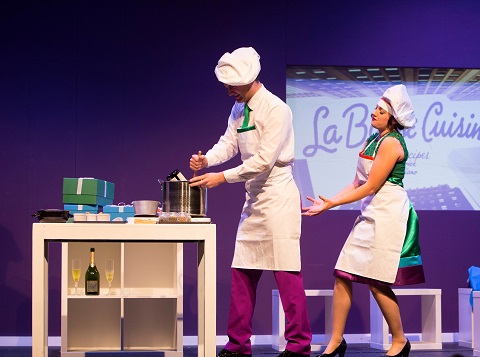 Ranald McCusker and Emma Nash. Photo Credit: Paula Malone Carty.
Ranald McCusker and Emma Nash. Photo Credit: Paula Malone Carty.
As we neared the close, I Hate Music!: A Cycle of Five Kid Songs
offered some less frequently performed fare. After ‘The Wrong Note Rag’, in
which Summerfield and soprano Rosemary Clifford demonstrated crystal-clear
diction, we were, inevitably, urged to ‘Make Our Garden Grow’ ( Candide); the singing was impassioned and intense, though I wasn’t
convinced that the a cappella episode was harmonically accurate.
Sadly, this year’s performance schedule meant that I had to miss the third
of the Short Works, Puccini’s La fanciulla del West, but
I did enjoy an unexpected musical bonus when Sir Thomas Allen took the
opportunity to turn this year’s Dr Tom Walsh Lecture into a musical
retrospective of his career, sharing and illustrating anecdotes of his
early musical experiences: his father’s band playing; the encouragement of
the Physics teacher who was eager to share the treasures of his LP
collection with his young charge; the singer’s own early misconception that
German songs were known as ‘lides’.
“Life has been one long serenade,” said Sir Thomas, after dulcetly crooning
Don Giovanni’s ‘Deh vieni alla finestra’. One might say the same of
Wexford. For those not able to attend this year’s Festival, the live streaming of Il bravo
on Saturday 27th October at 8pm, offers an opportunity to share
in the Festival spirit.
Claire Seymour
Giordano:
Mala vita
Vito – Sergio Escobar, Annetiello – Leon Kim, Cristina – Francesca Tiburzi,
Amalia – Dorothea Spilger, Marco – Benjamin Cho, Nunzia – Anna Jeffers
Leoni:
L’oracolo
Uin-ScÓ – Leon Kim, Cim-Fen – Joo Won Kang, Hu-Tsin – Benjamin Cho, San-Lui
– Sergio Escobar, Ah-Joe – Elisabetta Farris, Hua-QuÓ – Louise Innes, Hu-CÓ
– Cillian McCamley
Director – Rodula Gaitanou, Conductor – Francesco Cilluffo, Set and Costume
Designer – Cordelia Chisholm, Lighting Designer – Paul Hackenmueller,
Orchestra and Chorus of Wexford Festival Opera
National Opera House, Wexford; Friday 19th October 2018.
Bolcom: Dinner at Eight
(European premiere)
Millicent Jordon – Mary Dunleavy, Oliver Jordon – Stephen Powell, Paula
Jordon – Gemma Summerfield, Carlotta Vance – Brenda Harris, Dan Packard –
Craig Irvin, Kitty Packard – Susannah Biller, Larry Renault – Richard Cox,
Lucy Talbot – Sharon Carty, Dr Joseph Talbot – Brett Polegato, Max Kane –
Ashley Mercer, Gustave – Sheldon Baxter, Miss Copeland – Maria Hughes, Tina
– Laura Margaret Smith, Miss Alden – Gabrielle Dundon, Eddie – Ranald
McCusker, Mr Hatfield – Henry Grant Kerswell, Zolt·n – Feilimidh Nunan,
Supernumeraries – Alessandro Ambrosini, Elias Benito-Arranz, Chase Hopkins,
James Liu
Director – Tomer Zvulun, Conductor – David Agler, Set Designer – Alexander
Dodge, Costume Designer – Victoria Tzykun, Orchestra of Wexford Festival
Opera
National Opera House, Wexford; Saturday 20th October 2018.
Mercandante:
Il bravo
Il bravo – Rubens Pelizzari, Pisani – Alessandro Luciano, Foscari – Gustavo
Castillo, Luigi – Simon Mechli?ski, Teodora – Yasko Sato, Violetta –
Ekaterina Bakanova, Cappello -JosÈ de EÁa, Marco – Toni Neûi?, Un Messo –
Richard Shaffrey, Michelina – Ioana Constatin-Pipelea, Supernumeraries –
Susan Anderson, Sean Banfield, Martin Conway, Catherine Gaul, Colman
Hickey, Saran Moran, Sadhbh Murphy, Eoin O’Connor, Eoin Pinaqui, Alex
Saunders
Director – Renaud Doucet, Conductor – Jonathan Brandani, .Set & Costume
Designer – AndrÈ Barbe, Lighting Designer – Paul Hackenmueller, Orchestra
and Chorus of Wexford Festival Opera
National Opera House, Wexford; Sunday 21st October 2018.
Donizetti:
Don Pasquale
Don Pasquale – Toni Neûi?, Dr Malatesta – Simon Mechli?ski, Ernesto –
Antonio Mandrillo, Norina – Barbara Cole Watson, Carlino – Henry Grant
Kerswell
Music Director – Daniela Pellegrino, Stage Director – Kathleen Stakenas,
Stage & Costume Designer – Angela Giulia Toso, Lighting Designer –
Johann Fitzpatrick
Whites Clayton Hotel; Saturday 20th October 2018.
Bernstein ‡ la carte
Gemma Summerfield (soprano), Emma Nash (soprano), Rosemary Clifford
(mezzo-soprano), James Liu (tenor), Ranald McCusker (tenor), Jevan Mcauly
(bass), Owain Browne (bass)
Music Director – Tina Chang, Stage Director – Roberto Recchia, Stage &
Costume Designer – Angela Giulia Toso, Lighting Designer – Johann
Fitzpatrick
Whites Clayton Hotel; Sunday 21st October 2018.
image=http://www.operatoday.com/Dinner%20at%20Eight.jpg
image_description=
product=yes
product_title=Dinner at Eight, Wexford Festival Opera (European premiere, Saturday 20th October 2018)
product_by=A review by Claire Seymour
product_id= Above: Cast of Dinner at Eight